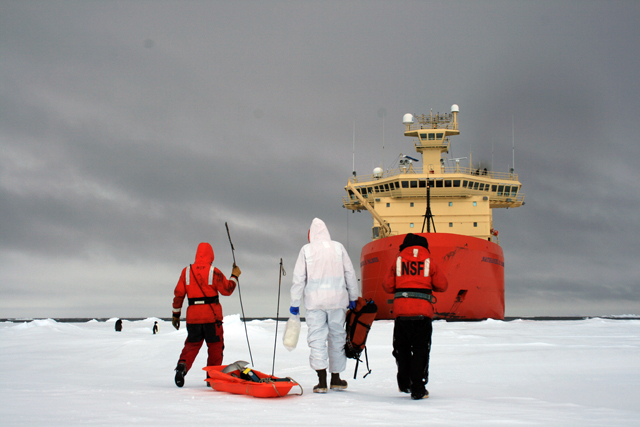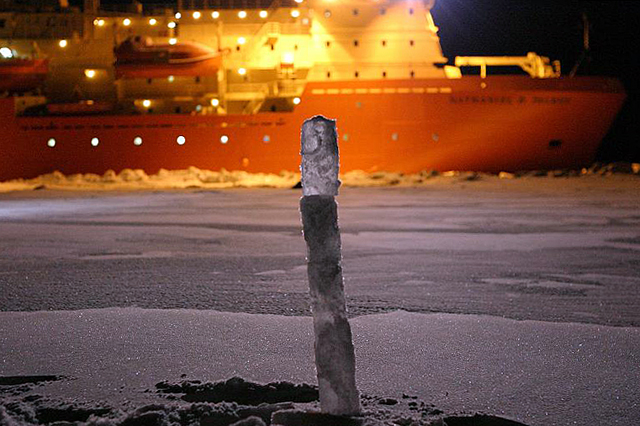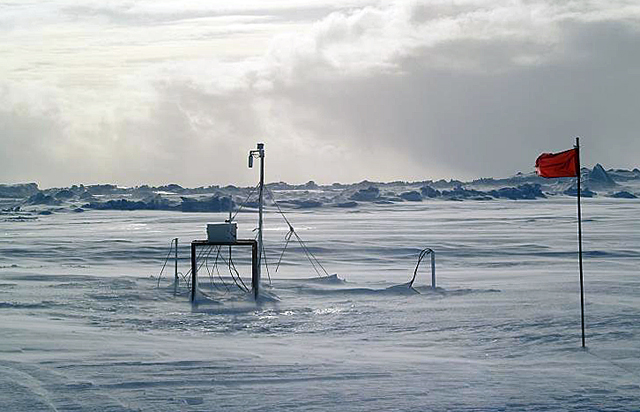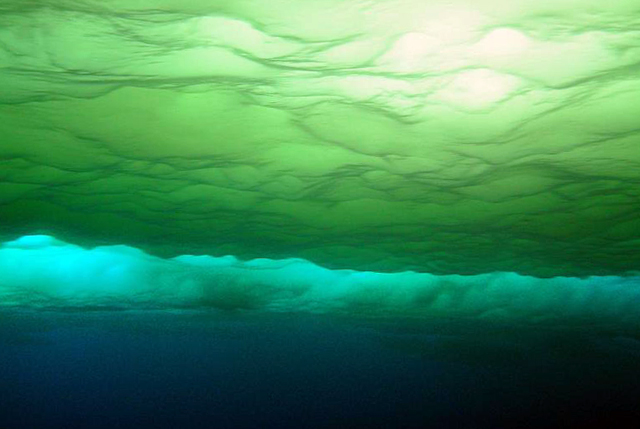Doubling upShip expedition to study biological and physical processes of sea icePosted December 10, 2010
Every September the sea ice Related Articles
It’s perhaps the world’s largest transient ecosystem, a key habitat for everything from microbes to penguins. Its physical processes have implications for global ocean circulation and the exchange of greenhouse gases with the atmosphere. Scientists aboard the Swedish icebreaker Oden The U.S. and Swedish researchers include glaciologists and biologists of different stripes, working on problems that range from sea ice thickness to the gases released to the atmosphere by microbial organisms living in and around the ice pack. “We’re all trying to work together in the sampling that we’ll be doing on the sea ice,” said Stephen Ackley 
Photo Credit: Anna-Carlijn Alderkamp
Scientists prepare to deploy a Go-Flow bottle from the stern of the NBP to collect water samples.
Sea ice helps regulate planetary temperatures in various ways. Freezing squeezes the salt out as the water solidifies. The dense and cold, salty water sinks, becoming part of a deep-ocean circulation system that distributes heat around the world. The ice also reflects solar radiation much more effectively than open water. When sea ice disappears, solar energy reflected by the ice instead warms the upper ocean. A warmer ocean leads to less ice, which exposes more water, and so on, to create a positive feedback loop. “The changes in sea ice production really have quite a major effect on the oceanic properties,” Ackley said. Getting precise sea ice thickness, structure and snow depth measurements are important parameters for other scientists whose jobs involve creating models that can accurately predict climate changes in the future. Toward that goal, Ackley’s team will release at least two remote buoys in the ice cover that will drift from the Amundsen Sea into the eastern Ross Sea over the next year. The instruments will measure variations in sea ice snow depth and ice thickness, as well as temperature gradients through the ice and into the ocean. One buoy also carries a device called a radiometer that can look at the bottom of the ice and observe changes in the biology. The team also hopes to coordinate its measurements with those of a NASA One instrument aboard the IceBridge DC-8 is a lidar, a laser altimeter that measures surface elevation. The Oden scientists will also employ an optical lidar from the ship. “The hope is that we can use the lidar data to measure surface elevation and couple it with our measurements of ice thickness and extend a technique we have for estimating the ice thickness from the surface elevation,” Ackley said. Ideally, the team would like to visit the same ice floes observed by the IceBridge campaign during October and November. However, by the time the Oden reaches the region in December, the same ice will have moved on. The scientists will try to use high-resolution satellite imagery to track it down. “That hasn’t been done before, and we’re not sure how it’s going to work out,” Ackley said. If it does work, the researchers can estimate sea ice volume over a large region. On the biological side of the expedition is a project under Kevin Arrigo at Stanford University The former, of course, is an important greenhouse gas that traps heat in the lower atmosphere. A component of that distinctive salty ocean odor, DMS is an important gas because of the chemical changes it undergoes in the atmosphere. The aerosols produced by those reactions help with cloud formation. Clouds play an important role in climate. “Some of it would be a positive feedback on climate, where if you produce a lot of [DMS], you nucleate clouds and you alter the radiation balance, so you send more heat back into space, which is a good thing,” Arrigo explained. “The other part is that some of gases are greenhouse gases, like nitrous oxide, which trap heat.” Members of Arrigo’s team will use an instrument aboard the Oden that measures gas concentrations in seawater pumped from the ocean into the ship. A spike in a gas of interest, such as DMS, will send the researchers into action, stopping the vessel to collect biological samples and drill cores into the sea ice. Incubation experiments on sea ice algae in the shipboard lab will analyze the production of sulfur compound gases like DMS and the consumption of CO2. Stateside experiments of samples will delve into genetics, looking at the diversity of the microscopic organisms. They will also look to see which genes are “switched” on and off under different conditions. “We don’t really have a good idea why they’re producing these sulfur compounds in the first place. Some people have suggested maybe as anti-freeze,” Arrigo said. “We hope we can tease out [genetically] why they’re producing these things.” Arrigo said his group would work closely with Swedish scientists aboard the Oden working on the chemical characteristics in the sea ice while Ackley’s physics data will be important for interpreting the biological results. “The physics is really important in terms of understanding distributions of algae within the sea ice,” Arrigo said. “If there’s too much snow, there’s not enough light. Too little snow and you may have too much light, depending on where the algae are growing. “If they weren’t doing [the physics], we’d have to do it ourselves. It’s that important for us to know,” he added. The Oden is scheduled to leave port in early December. Said Ackley, “We’re very excited to be working on the Oden. It’s a great vessel for doing this. It’s really the only way of getting in there. The cooperation with the Swedes has been really good up to now, and we look forward to continuing it in the future. It looks like a pretty exciting trip.” NSF-funded research in this article: Stephen Ackley, University of Texas at San Antonio, Award No. 0839053
|



For USAP Participants |
For The Public |
For Researchers and EducatorsContact UsU.S. National Science FoundationOffice of Polar Programs Geosciences Directorate 2415 Eisenhower Avenue, Suite W7100 Alexandria, VA 22314 Sign up for the NSF Office of Polar Programs newsletter and events. Feedback Form |






